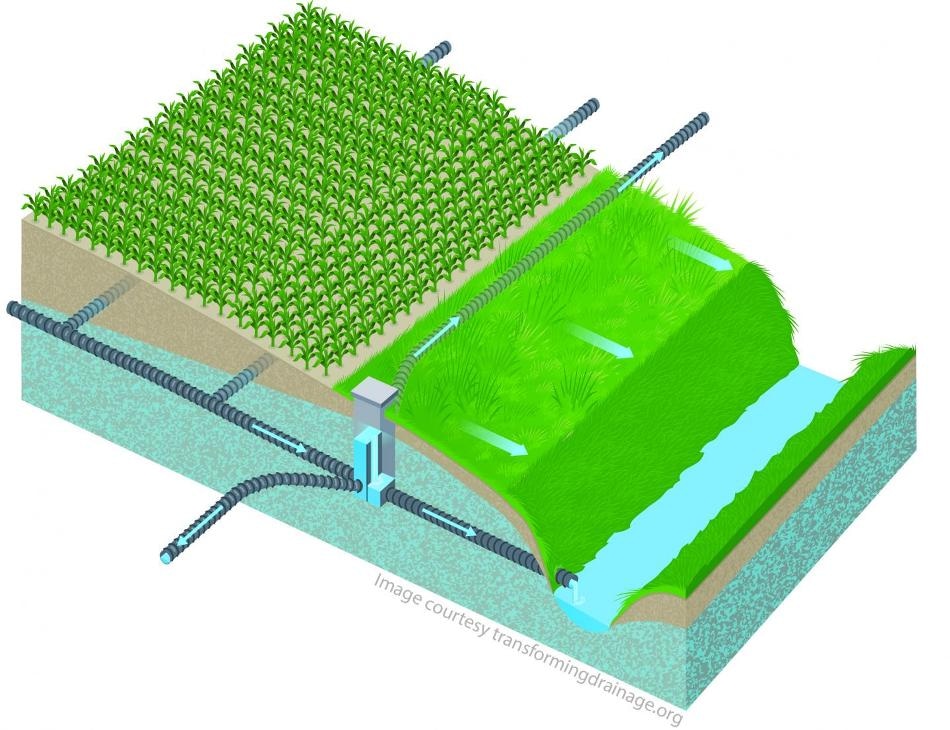Jan 16 2019
A “dead zone” is created in the Gulf of Mexico every summer. Plumes of oxygen-robbing algae feeding on surplus nitrogen coming in from the Mississippi River destroy marine life and put the livelihoods of those who catch fish in the Gulf at stake.
 University of Illinois researchers found that, if adopted on a wide scale throughout the Midwest, saturated buffers could reduce nitrogen pollution entering the Gulf of Mexico by 5%–10%. (Image credit: Transforming Drainage)
University of Illinois researchers found that, if adopted on a wide scale throughout the Midwest, saturated buffers could reduce nitrogen pollution entering the Gulf of Mexico by 5%–10%. (Image credit: Transforming Drainage)
States around the Mississippi River are setting up strategies to restrict nitrogen from agricultural fields, surface runoff, and wastewater treatment plants. As part of a new study, researchers from the University of Illinois have estimated that a 5%–10% reduction in nitrogen from agricultural drainage is possible using a new conservation practice called saturated buffers.
It might not sound like much, given that agricultural drainage only represents a portion of the nitrogen getting into the Mississippi. But 5 to 10 percent is pretty good for an inexpensive, passive system that farmers can put in and forget about.
Reid Christianson, Research Assistant Professor, Department of Crop Sciences, University of Illinois.
Reid Christianson is the co-author of the study published in Agricultural and Environmental Letters.
Saturated buffers are narrow pieces of vegetated land measuring as small as 30 feet across—lying between waterways and tile-drained agricultural fields. Normally, tile pipes carrying drainage water from the fields pour out directly into streams or ditches. A saturated buffer re-directs the water to a perforated pipe running underneath the surface and parallel to the stream. Subsequently, water flows into the stream through the soil of the saturated buffer. The microbes in the soil naturally eliminate up to 44% of the nitrogen as water flows through it.
Saturated buffers don’t take a lot of land out of production, and are fairly inexpensive at $3,000 to $4,000 to treat drainage from a field-sized area (roughly 30 to 80 acres). Farmers have to be willing to not farm right up to the creek, but in terms of edge-of-field conservation practices, I think saturated buffers fit easily with farming and provide additional benefits like wildlife and pollinator habitat.
Laura Christianson, Assistant Professor, Department of Crop Sciences, University of Illinois.
Laura Christianson is the other co-author of the study.
In order to determine their nitrogen reduction estimate, the Christiansons and doctoral student Janith Chandrasoma analyzed openly available digital maps of soil, crop, and stream types to predict the total number of saturated buffers that could be set up across the Midwest: 248,000 to 360,000, which could treat up to 9.5 million acres of drained land. Since other studies demonstrate average nitrogen removal rates of 23%–44%, this number of saturated buffers would limit the total nitrogen load in agricultural drainage by 5%–10%.
According to Laura, several assumptions were needed for this approach. For instance, no satellite images or maps are available for tile drainage systems across the whole of the Midwest; therefore, the scientists assumed that corn or soybean fields on soil characterized as “poorly drained” were most probably tiled. However, Reid notes that tile drainage systems are installed not only in poorly drained ones but also under a number of corn and soybean fields in the Midwest.
“Overall, our assumptions were relatively conservative. We probably underestimated our figures as a result,” he says.
With the first Natural Resources Conservation Service standard announced in 2016, saturated buffers are a new conservation practice. To date, this practice has not been adopted anywhere near the range shown possible in the Christiansons’ study. For instance, Laura approximates that, at present, there are possibly less than 50 saturated buffers operating across the whole of the Midwest area.
“Adoption on the scale we estimated in the paper is likely a long way off,” she says, “but anything we can do to reduce nitrogen flowing to the Gulf, especially if it fits relatively easily with current on-farm management practices, warrants attention.”